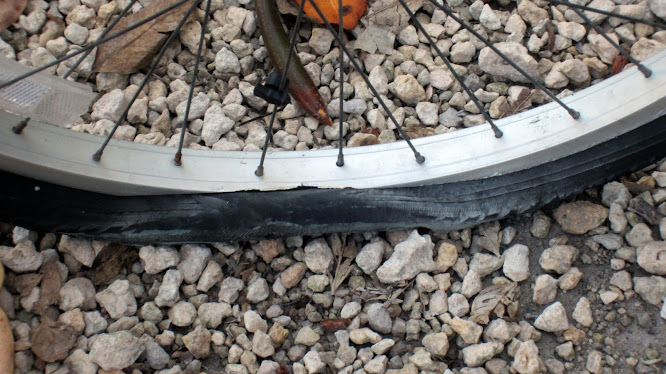 |
| U.S. 1 headed toward Jewfish Creek |
 |
| Little Blackwater Sound, a protected crocodile habitat. |
It has
been an interesting ride so far. I learned yet another lesson about
Recreational Vehicles as I had yet another heart-stopping mishap with
my bike rack. Just because everybody else seems to do it doesn't
mean it's the right way, or even the safe way, to do something. Let
me 'splain.
I ended up dragging both my bikes along U.S. 41 in the
middle of the Everglades when my bike carrier broke off at the base.
Yes, again. I was only doing about thirty miles an hour at the time,
but it made no difference as I was in the middle of a one-lane
construction zone and could not get off the road. I'm positive it
was the incredible pounding the rack took when we rode over several
exaggerated rumble-strips. We didn't stop until we turned off the
Tamiami Trail onto Krome Avenue. Mangled was the word that came to
mind as I walked around the back of the camper and saw the remnants
of the two bicycles securely attached to the rear bumper of the
camper by a safety strap. I always put the strap on anything I carry
outside a vehicle, and twice now, the safety strap saved me grief
when something broke on the bumper hitch-mounted bike rack. This
time, the carrier broke off at the weld at the bottom of the frame.
We
loaded the damaged bicycles in the camper and propped them against
the dinette table so they wouldn't move around and damage the
interior. I tossed the broken bike carrier in the SUV for later
inspection, and started down State Road 997, the two-lane road that
is forty years overdue widening. Formerly known as US 27, and commonly known as Krome Avenue, the road hasn't changed
much since we lived not far from the dangerous road many years ago.
It certainly hasn't changed since it won world-wide notoriety during
the Cuban Mariel boat-lift of 1980. Several traffic lights were
added back in the early nineties, but the heavily traveled alternate
road to south Miami-Dade County is still well overdue for
modernization and widening.
 |
| Welcome to John Pennekamp Ocean Reef State Park |
The only concession to safety on the bloody stretch of U.S.1 south of Florida City is a permanent concrete Jersey barrier, painted an appealing, Eco-friendly, sea-foam green, that now divides the two-lane road down the entire eighteen mile stretch of highway. Efforts to modernize and four-lane the road have always been defeated by those interests who want less traffic in the Keys, while all the while the Greater Keys Chamber of Commerce, along with the City of Key West and many other Keys-based tourist businesses, spend millions of dollars on world-wide advertising extolling the wondrous beauty of this unique tourist destination. In short, we ask German, French, and other European tourists to fly to Miami, rent a car and drive to the Keys and possibly get killed on a highway we don't want them to use. The almost daily head-on collisions have at least been eliminated by the concrete wall divider. Bad road or not, they come from around the world anyway. Europeans definitely make up a good portion of the tourists we meet in the keys, and many of them make John Pennekamp Ocean Reef State Park one of their first stops. The very first couple we meet and talk with are from Stockholm, Sweden.
 |
| All 47 sites have recently been renovated to include full hookup. Reservations must be made well in advance of trip |
The Pennekamp park is one of our favorites, and the recently renovated campground makes it all the better. The campground recently converted all forty-seven campsites to full sewer hookup. With both 30 amp and 50 amp electrical service, water, and now sewer, the sea-shell gravel pads are just about perfect. Level, with nice separation between sites, with both shower and laundry facilities, the campground rates as one of the nicest we've visited. We can hardly wait to unhook and kick back.






